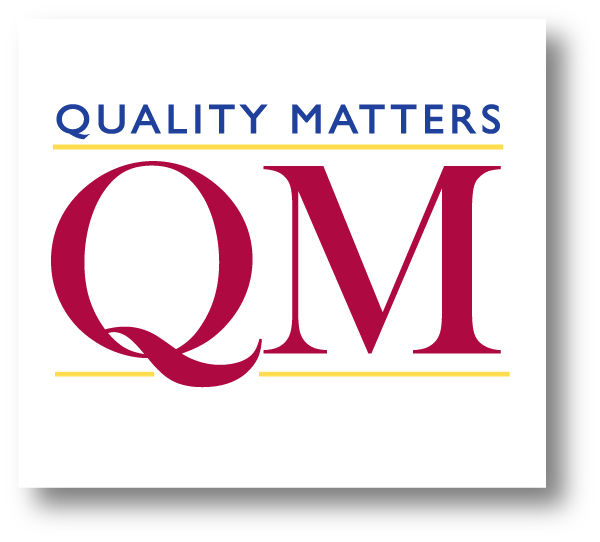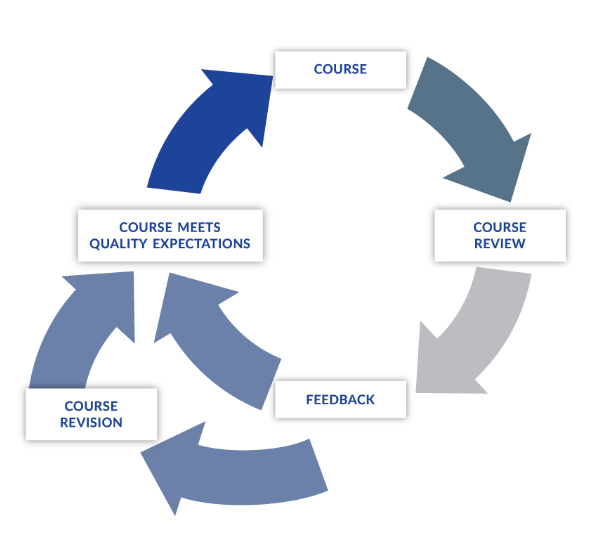What Is Quality Matters?

Understanding Quality Matters (QM) & How Students Benefit from QM-Certified Courses
Within almost every field, quality assurance is established to ensure that products or services consistently meet quality standards. So, why wouldn’t quality assurance exist within the realm of online education? In 2003, a group of educators in the MarylandOnline, Inc. Consortium came together to ask that very question: How do we measure and guarantee the quality of an online course? This question became especially important as more and more higher education institutions began offering online and blended courses. As a result, the Quality Matters (QM) organization was founded.
Key Takeaways
-
- QM provides a research-based framework for designing, reviewing, and revising online courses to ensure they meet established standards of quality.
- QM emphasizes a collegial and collaborative review process, involving faculty with recent online teaching experience or instruction designers specializing in online course development.
- QM is recognized internationally as the gold standard for quality assurance in online education. QM-certified courses result in increased student engagement, improved grades, and higher GPAs.
Underlying Principles of Quality Matters
Quality Matters provides a framework for designing, reviewing, and revising online courses to ensure that they meet research-supported standards of quality. QM achieves this through three primary components:
- A research-based rubric
- Peer reviews of courses and programs
- Professional development for faculty and staff
QM is built upon four underlying principles:
- Continuous— The QM peer review process isn’t just a one-time pass or fail grade; instead, it is an ongoing, continuous cycle.
- Centered— QM revolves around research, student learning, and quality, with all practices and processes anchored in these three elements.
- Collegial— The review process is designed to be diagnostic and collaborative rather than evaluative and judgmental. Course reviews are conducted by current online instructors or instructional designers rather than administrators or academics who are removed from teaching.
- Collaborative— A QM review doesn't rely on the personal opinions or experiences of one reviewer. Instead, it's based on evidence from the course, collaboratively identified by the whole review team using the QM rubric.
The current QM Rubric, launched in 2023, consists of 44 specific criteria clustered into 8 categories that serve as a comprehensive guide for evaluating the design of online and blended courses. The QM rubric is updated approximately every five years to reflect current research and best practices that have emerged.

How It Works
The course review begins with the faculty who designed the course applying to get the course reviewed. This is where Carolyn Stoll, MA and Director of Online Instruction at University of Cincinnati (UC) Online, and her Instructional Design team step in to lead the QM review process. Stoll says, “I love working with faculty in the QM process, because just signing up for a review means you’ve made a commitment to quality teaching. It’s not a walk in the park to get your course reviewed, and it requires courage to ask total strangers to tell you what’s wrong with your course. I admire that courage and applaud their commitment to their craft.” Once a course review is initiated, a review team is then assembled. UC is part of the Ohio QM Consortium, an organization comprised of more than 50 QM subscribing institutions in Ohio. The Ohio QM Consortium operates on a bartering system (yes, you read that correctly), which allows schools to trade course reviews and peer reviewers back and forth, eliminating the need to pay for a review. The review team consists of three members, who are either faculty with recent online teaching experience or instructional designers specializing in online course development. All members undergo training in applying the Quality Matters Rubric and providing constructive feedback. Each team includes a Master Reviewer, a Subject Matter Expert, and a Peer Reviewer, with at least one member external to the institution (usually all three are).
Review Timeline
After a course is prepared for review, a pre-review call is conducted with faculty and the review team.
Reviews typically last 3-4 weeks during which time the review team looks for evidence within the course that the 44 standards are met. To be certified, the course must meet all Essential Standards and score 86 out of 101 points on the QM Rubric. If initial standards aren’t met, a 14-week Amendment period allows for revisions. Upon completion, the Review Team Chair confirms compliance, leading to certification and display of the QM Certification Badge. Certification is valid for five years or until significant course changes occur. Recertification only requires a Master Reviewer to confirm the course still meets standards.

University of Cincinnati Insight
Andrea Sizemore, Senior Instructional Designer at UC Online, speaks of the QM review process, “UC Online supports instructors—the content experts—by supporting just as we would through a course design process. We help ensure alignment, student engagement, and brainstorm with instructors about how to help best support students in their learning. We let the instructors know they are not alone in this process by walking them through every step and lending a hand where we can.” Shaunak Sastry, PhD, is an Associate Professor in the UC School of Communication, Film & Media Studies who recently had his COMM 2004 “Communicating Health, Science and the Environment” course (offered within the UC Online Bachelor of Arts in Communication program) reviewed and was granted QM certification. Sastry reflects, “Because I teach courses that ask students to reflect on their assumptions, deal with global health and environmental issues, and expect a fair degree of reflexive writing, the peer-reviewed aspect of QM is particularly important to me. I do feel that I am able to offer a much more streamlined, student-learning focused, and accessible course as an instructor.” Sizemore adds, “It’s always exciting to work with others from other institutions as it offers new perspectives and examples to ensure students are getting the best from their online courses. We love getting to be thought partners and work collaboratively with online instructors to best support the students. We also realize this is a heavy lift for instructors so when we see instructors volunteer to do this work, it makes a great experience because we all have the student’s best interest at heart.” The following UC courses have been reviewed and received QM certification:
Course |
Instructor |
College |
Program |
| AFST 1005: Introduction to Global Health Studies | Guy Whembolua | College of Arts & Sciences | General BOK |
| CJ 3075: Cybersecurity | Joe Nedelec | College of Education, Criminal Justice, and Human Services, with the School of Information Technology | Criminal Justice |
| COMM 2004: Communicating Health, Science, and the Environment | Shaunak Sastry | College of Arts & Sciences | Communication |
| COMM 3007: Introduction to Communication Theory | MJ Woeste | College of Arts & Sciences | Communication |
| COMM 3039: Communication Research Methods | Michelle Colpean | College of Arts & Sciences | Communication |
| HCMT 2014: Physician's Practice | Lorene Scott | UC Clermont | Physician's Practice |
| HCMT 2045: Healthcare Compliance | Latrina Hyde | UC Clermont | Healthcare Management Technology |
| HCMT 2064: Abstracting Methods | Melissa Shankey | UC Clermont | Cancer Registry |
| HPE 1005: Mental Health Issues | Kelsi Becker | UC Blue Ash | Public Health |
| IT 2020: Implications of Information Security | Kristi Hall | UC Clermont | Information Technology |
| IT 2040: Intro to Web Development | Kristi Hall | UC Clermont | Information Technology |
Importance of Quality Matters
QM is now an internationally recognized program and is considered the gold standard for quality assurance goals & certification in online and blended courses. Today, QM has over 1,500 member institutions across all 50 US states and 32 countries around the world. The organization has also trained more than 60,000 education professionals on online course design standards and certified thousands of online and blended courses. A recent study (Baranovic) found that QM-certified courses resulted in 26% greater engagement, a 2-7% increase in grades (depending on academic term), and a 1.25% increase in the GPA for students in all online courses.
Stoll says, “I know that every course that’s certified is one more course that’s more student-centric, more accessible, more aligned to course objectives, simply a better learning experience for the students. That’s my and my team’s job – to improve the student learning experience because when students have a better learning experience, they’re more likely to persist and get their degree, which is life-changing. That’s what it’s all about, in the end.”